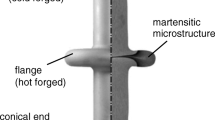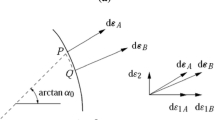Abstract
Advanced simulations are needed in the industry nowadays for reliable design of various machine parts. A complex computation is presented here to describe the whole manufacturing process, apart from the machining, of forged spur gear for a reverse transmission from a car gearbox. A coupled thermomechanical analysis was realized through the explicit finite element method, while the stress–strain analysis was conducted in all phases of the production with time- and temperature-dependent constitutive law. The influence of process parameters was assessed, and the magnitudes of forging load were compared for selected dimensions of intermediate product (blank) and its initial temperature (preheating). The numerical simulation was finished with the flash trimming along the circumference, so the temperature-dependent ductile failure criterion proposed by Johnson and Cook was accounted for as well.



















Similar content being viewed by others
References
G. Surdon and J.L. Chenot, Finite Element Calculation of Three-Dimensional Hot Forging, Int. J. Numer. Methods Eng., 1987, 24(11), p 2107–2117
J.H. Yoon and D.Y. Yang, A Three-Dimensional Rigid-Plastic Finite Element Analysis of Bevel Gear Forging by Using a Remeshing Technique, Int. J. Mech. Sci., 1990, 32(4), p 277–291
N. Kim and S. Kobayashi, Preform Design in H-Shaped Cross Sectional Axisymmetric Forging by the Finite Element Method, Int. J. Mach. Tools Manuf., 1990, 30(2), p 243–268
T. Coupez, N. Soyris, and J.-L. Chenot, 3-D Finite Element Modelling of the Forging Process with Automatic Remeshing, J. Mater. Process. Technol., 1991, 27(1-3), p 119–133
D.Y. Yang, N.K. Lee, J.H. Yoon, J.L. Chenot, and N. Soyris, A Three-Dimensional Rigid-Plastic Finite Element Analysis of Spur Gear Forging Using the Modular Remeshing Technique, Proc. Inst. Mech. Eng. Part B, 1991, 205(2), p 111–121
V. Szentmihali, K. Lange, Y. Tronel, J.-L. Chenot, and R. Ducloux, 3-D Finite-Element Simulation of the Cold Forging of Helical Gears, J. Mater. Process. Technol., 1994, 43(2-4), p 279–291
M.L. Alves, J.M.C. Rodrigues, and P.A.F. Martins, Cold Forging of Gears: Experimental and Theoretical Investigation, Finite Elem. Anal. Des., 2001, 37(6-7), p 549–558
J. Cai, T.A. Dean, and Z.M. Hu, Alternative Die Designs in Net-Shape Forging of Gears, J. Mater. Process. Technol., 2004, 150(1-2), p 48–55
B.I. Tomov, V.I. Gagov, and R.H. Radev, Numerical Simulations of Hot Die Forging Processes Using Finite Element Method, J. Mater. Process. Technol., 2004, 153-154, p 352–358
H.S. Jeong, J.R. Cho, and H.C. Park, Microstructure Prediction of Nimonic 80A for Large Exhaust Valve During Hot Closed Die Forging, J. Mater. Process. Technol., 2005, 162-163, p 504–511
M. Skunca, P. Skakun, Z. Keran, L. Sidjanin, and M.D. Math, Relations Between Numerical Simulation and Experiment in Closed Die Forging of a Gear, J. Mater. Process. Technol., 2006, 177(1-3), p 256–260
K.S. Park, Ch.J. VanTyne, and Y.H. Moon, Process Analysis of Multistage Forging by Using Finite Element Method, J. Mater. Process. Technol., 2007, 187-188, p 586–590
B.-A. Behrens, Finite Element Analysis of Die Wear in Hot Forging Processes, CIRP Ann., 2008, 57(1), p 305–308
M.H.A. Bonte, L. Fourment, T.-t. Do, A.H.v.d. Boogaard, and J. Huétink, Optimization of Forging Processes Using Finite Element Simulations, Struct. Multidisc. Optim., 2010, 42, p 797–810
P.F. Bariani, S. Bruschi, A. Ghiotti, and M. Simionato, Ductile Fracture Prediction in Cold Forging Process Chains, CIRP Ann., 2011, 60(1), p 287–290
J.C. Gelin and A. Moisan, Finite Element Analysis of Ductile Fracture and Defects Formation in Cold and Hot Forging, CIRP Ann., 1990, 39(1), p 215–218
V.C. Hoa, D.W. Seo, and J.K. Lim, Site of Ductile Fracture Initiation in Cold Forging: A Finite Element Model, Theor. Appl. Fract. Mech., 2005, 44(1), p 58–69
J. Landre, A. Pertence, P.R. Cetlin, J.M.C. Rodrigues, and P.A.F. Martins, On the Utilisation of Ductile Fracture Criteria in Cold Forging, Finite Elem. Anal. Des., 2003, 39(3), p 175–186
H.-S. Kim, Y.-T. Im, and M. Geiger, Prediction of Ductile Fracture in Cold Forging of Aluminum Alloy, J. Manuf. Sci. Eng., 1999, 121(3), p 336–344
S.W. Lee and M.S. Joun, Rigid-Viscoplastic Finite Element Analysis of the Piercing Process in the Automatic Simulation of Multi-Stage Forging Processes, J. Mater. Process. Technol., 2000, 104(3), p 207–214
C. MacCormack and J. Monaghan, Failure Analysis of Cold Forging Dies Using FEA, J. Mater. Process. Technol., 2001, 117(1-2), p 209–215
J. Guo, B. Liao, L.-G. Liu, Q. Li, X.-J. Ren, and Q.-X. Yang, Forging Limit of a Novel High-Speed-Steel Cold Work Roll Based on Ductile Fracture Criteria by Finite Element Model, Mater. Des., 2013, 52, p 1027–1034
L. Niu, W. Wei, K.X. Wei, I.V. Alexandrov, and J. Hu, 3D Finite Element Analysis of Spider Non-Isothermal Forging Process, J. Mater. Eng. Perform., 2016, 25(6), p 2536–2541
F. Li, J. Yi, and J. Eckert, Optimization of the Hot Forging Processing Parameters for Powder Metallurgy Fe-Cu-C Connecting Rods Based on Finite Element Simulation, Metall. Mater. Trans. A, 2017, 48(12), p 6027–6037
S.W. Lee, J.M. Lee, and M.S. Joun, On Critical Surface Strain During Hot Forging of Lubricated Aluminum Alloy, Tribol. Int., 2020, 141, p 105855
R. Hari Krishna and D.P. Jena, Analytical and Numerical Modelling of Open-Die Forging Process for Elliptical Cross-Section of Billet, Measurement, 2019, 134, p 855–865
W. Zhuang, X. Han, L. Hua, M. Xu, and M. Chen, FE Prediction Method for Tooth Variation in Hot Forging of Spur Bevel Gears, J. Manuf. Process., 2019, 38, p 244–255
G. Chu, L. Sun, G. Wang, Z. Fan, and H. Li, Axial Hydro-Forging Sequence for Variable-Diameter Tube of 6063 Aluminum Alloy, J. Mater. Process. Technol., 2019, 272, p 87–99
A.J. Williams, T.N. Croft, and M. Cross, Computational Modelling of Metal Extrusion and Forging Processes, J. Mater. Process. Technol., 2002, 125-126, p 573–582
H.Y. Wen, X.H. Dong, and X.Y. Ruan, Meshfree Method Based on Point Collocation for Metal Forming Simulation, Acta Metall. Sin. (Engl. Lett.), 2006, 19(2), p 79–84
P.W. Cleary, M. Prakash, R. Das, and J. Ha, Modelling of Metal Forging Using SPH, Appl. Math. Model., 2012, 36(8), p 3836–3855
A. Chamanfar, H.S. Valberg, B. Templin, J.E. Plumeri, and W.Z. Misiolek, Development and Validation of a Finite-Element Model for Isothermal Forging of a Nickel-Base Superalloy, Materialia, 2019, 6, p 100319
P. Kubík, Minimization of Residual Stresses for Rolled Long Products, Master’s Thesis, Brno University of Technology, 2009
G.R. Johnson and W.H. Cook, A Constitutive Model and Data for Metals Subjected to Large Strains, High Strain Rates and High Temperatures, in Proceedings of the 7th International Symposium on Ballistics, The Hague, Netherlands, 1983, p 541–547
J. Bořkovec, Computer Simulation of Material Separation Process, PhD Thesis, Brno University of Technology, 2008
ČSN 22 8306, Closed Dies for Vertical Forging Presses: Technical Requirements on the Design, Prague: Publisher of Standards, Class number 22 8306, 1991
G.R. Johnson and W.H. Cook, Fracture Characteristics of Three Metals Subjected to Various Strains, Strain Rates, Temperatures and Pressures, Eng. Fract. Mech., 1985, 21(1), p 31–48
T. Wierzbicki, Y. Bao, Y.-W. Lee, and Y. Bai, Calibration and Evaluation of Seven Fracture Models, Int. J. Mech. Sci., 2005, 47(4–5), p 719–743
F. Šebek, P. Kubík, J. Petruška, and J. Hůlka, Extremely Low-Stress Triaxiality Tests in Calibration of Fracture Models in Metal-Cutting Simulation, Metall. Mater. Trans. A, 2016, 47(11), p 5302–5312
Ch.Z. Duan, H.Y. Yu, Y.J. Cai, and Y.Y. Li, Finite Element Simulation and Experiment of Chip Formation During High Speed Cutting of Hardened Steel, Appl. Mech. Mater., 2010, 29–32, p 1838–1843
J. Kvapil, Thermal Contact Resistance Under High Temperature, Master’s Thesis, Brno University of Technology, 2016
ČSN 41 2050, Steel 12050, Prague: Publisher of the Office for Standards and Testing, Class number 41 2050, 1978
L. Koudela, Numerical Modelling and Optimization of the Hot Stamping Process, PhD Thesis, University of West Bohemia, 2015
B. Zeramdini, C. Robert, G. Germain, and T. Pottier, Numerical Simulation of Metal Forming Processes with 3D Adaptive Remeshing Strategy Based on a Posteriori Error Estimation, Int. J. Mater. Form., 2019, 12, p 411–428
Acknowledgment
This work was supported by the Czech Science Foundation under contract No. 19-20802S “A coupled real-time thermomechanical solidification model of steel for crack prediction.” The authors would also like to thank professor Josef Štětina and associate professor Michal Pohanka, both with the Faculty of Mechanical Engineering, Brno University of Technology, for providing us with the material data for the considered carbon steel.
Author information
Authors and Affiliations
Corresponding author
Ethics declarations
Conflict of interest
The authors declare that they have no conflict of interest.
Additional information
Publisher's Note
Springer Nature remains neutral with regard to jurisdictional claims in published maps and institutional affiliations.
Rights and permissions
About this article
Cite this article
Nytra, M., Kubík, P., Petruška, J. et al. A Fully Coupled Thermomechanical Damage Analysis of Hot Closed Die Forging Using Finite Element Modeling. J. of Materi Eng and Perform 29, 8236–8246 (2020). https://doi.org/10.1007/s11665-020-05252-4
Received:
Revised:
Accepted:
Published:
Issue Date:
DOI: https://doi.org/10.1007/s11665-020-05252-4




